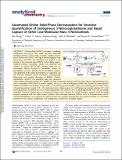Automated Online Solid-Phase Derivatization for Sensitive Quantification of Endogenous
Author(s)
Wang, Xin; Garcia, Carlos T.; Gong, Guanyu; Wishnok, John S; Tannenbaum, Steven R
Downloadacs.analchem.7b04049.pdf (3.134Mb)
PUBLISHER_POLICY
Publisher Policy
Article is made available in accordance with the publisher's policy and may be subject to US copyright law. Please refer to the publisher's site for terms of use.
Terms of use
Metadata
Show full item recordAbstract
S-Nitrosothiols (RSNOs) constitute a circulating endogenous reservoir of nitric oxide and have important biological activities. In this study, an online coupling of solid-phase derivatization (SPD) with liquid chromatography-mass spectrometry (LC-MS) was developed and applied in the analysis of low-molecular-mass RSNOs. A derivatizing-reagent-modified polymer monolithic column was prepared and adapted for online SPD-LC-MS. Analytes from the LC autosampler flowed through the monolithic column for derivatization and then directly into the LC-MS for analysis. This integration of the online derivatization, LC separation, and MS detection facilitated system automation, allowing rapid, laborsaving, and sensitive detection of RSNOs. S-Nitrosoglutathione (GSNO) was quantified using this automated online method with good linearity (R[superscript 2] = 0.9994); the limit of detection was 0.015 nM. The online SPD-LC-MS method has been used to determine GSNO levels in mouse samples, 138 ± 13.2 nM of endogenous GSNO was detected in mouse plasma. Besides, the GSNO concentrations in liver (64.8 ± 11.3 pmol/mg protein), kidney (47.2 ± 6.1 pmol/mg protein), heart (8.9 ± 1.8 pmol/mg protein), muscle (1.9 ± 0.3 pmol/mg protein), hippocampus (5.3 ± 0.9 pmol/mg protein), striatum (6.7 ± 0.6 pmol/mg protein), cerebellum (31.4 ± 6.5 pmol/mg protein), and cortex (47.9 ± 4.6 pmol/mg protein) were also successfully quantified. When the derivatization was performed within 8 min, followed by LC-MS detection, samples could be rapidly analyzed compared with the offline manual method. Other low-molecular-mass RSNOs, such as S-nitrosocysteine and S-nitrosocysteinylglycine, were captured by rapid precursor-ion scanning, showing that the proposed method is a potentially powerful tool for capture, identification, and quantification of RSNOs in biological samples.
Date issued
2018-02Department
Massachusetts Institute of Technology. Department of Biological Engineering; Massachusetts Institute of Technology. Department of ChemistryJournal
Analytical Chemistry
Publisher
American Chemical Society (ACS)
Citation
Wang, Xin, Carlos T. Garcia, Guanyu Gong, John S. Wishnok, and Steven R. Tannenbaum. “Automated Online Solid-Phase Derivatization for Sensitive Quantification of Endogenous S-Nitrosoglutathione and Rapid Capture of Other Low-Molecular-Mass S-Nitrosothiols.” Analytical Chemistry 90, no. 3 (January 9, 2018): 1967–1975. © 2017 American Chemical Society
Version: Author's final manuscript
ISSN
0003-2700
1520-6882